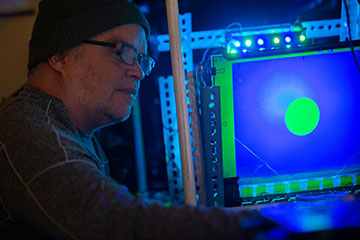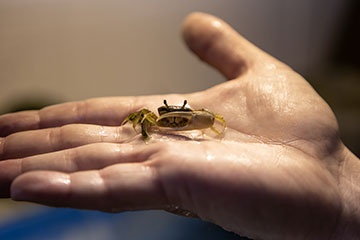
UC biologist John Layne with the modified LCD setup. [Image: Andrew Higley/UC Creative Services]
Understanding how animals see the world, as well as how this sensory information guides their behavior, can be incredibly valuable to researchers. But simulating animal vision can be difficult if the tools you are using are specifically designed with the human visual system in mind.
Now, researchers at the University of Cincinnati (UC), USA, have modified simple, inexpensive liquid crystal displays (LCDs) to better test color vision in animals (Methods Ecol. Evol., doi: 10.1111/2041-210X.13375).
Biological solutions to technological problems
The value of studying animals, says former UC student and co-author Jeremiah Didion, is exploration. “You never know where the next big contribution to science will come from,” he says. “It’s been demonstrated multiple times that animals have figured out biological solutions to our technological problems—including active sonar, cameras and plane and drone designs, just to name a few.”
However, studying animal vision has its challenges. Researchers can try to re-create an animal’s visual experience using computer displays, but these LCD screens have been optimized for human eyes, using a combination of red, blue and green (RGB) light to create thousands of colors. Without prior knowledge of an animal’s spectral sensitivity, it’s difficult to mimic that animal’s color-perceptual experience with an RGB display. These displays also can’t generate UV wavelengths—yet many animals have photoreceptors with peak absorbances in the UV.
“The issue is that these manufactured colors are geared to human perception based on our photoreceptors’ sensitivity curves and thousands of hours of human psychophysical testing,” says Didion, who is now a postdoc at Case Western University, USA. “However, most animals do not share the same photoreceptor sensitivity curves that we do, meaning what we perceive as a certain color might not be what the animal we are testing is seeing.”
LED versus RGB
The researchers wanted to find a way to test color vision in animals without needing prior knowledge of the animal’s photoreceptor sensitivities—and they wanted to do it on the cheap. The first stop was the UC warehouse, where the researchers found an old LCD computer monitor to form the basis for the setup. One benefit of the system that keeps it cost-effective, Didion says, “is it allows for the repurposing of technology.” They bought breadboards, wiring kits, visible spectrum LEDs, angle iron, polarizing film, expanded PVC, and some nuts, bolts and washers to complete the setup.
“Overall, a setup that can test visible light can be constructed for a couple hundred bucks,” says Didion. Of course, he says, testing UV light increases the expense, and he notes that the UC team’s setup also included a portable calibrated spectrometer, another cost.
Trading traditional RGB lights for LEDs gave the team access to many more wavelength and intensity combinations that could be transmitted through the screen.

UC biologists are studying the color vision of fiddler crabs. [Image: Andrew Higley/UC Creative Services]
Testing crab vision
In a standard twisted nematic LCD screen, a nematic liquid crystal is sandwiched between two plates of polarized glass, oriented 90 degrees to each other. After passing through one polarizing filter that orients the light in one direction, nematic panels “twist” the polarized light so that it is either blocked by the second polarizer, resulting in an “OFF” pixel, or it shines through, an “ON” pixel.
To construct their display, the team took apart the monitor and replaced the front polarizer (on the viewing side) and added two diffusers. They then backlit the screen with two different colors of LEDs. By applying two orthogonal polarizers to the two LED colors, the screen then shows one color where there would normally be black, and the other color where there would normally be white.
To test their device, the team set up an experiment with crabs to measure their escape response to a dichromatic looming stimulus—a video of a fast-approaching circle appearing on the modified screen. This two-LED configuration—blue and green—tested the crabs’ color discrimination. A one-LED configuration with a monochromatic stimulus allowed the researchers to test the animals’ color sensitivity.
Future vision research
The researchers hope that their setup will allow for more accurate testing of the role of color in visually guided behaviors by allowing for greater control over the wavelengths and intensity of visual stimuli, which could benefit vision research. For example, says Didion, the findings could potentially influence how certain technology circuitry is wired to solve various visual tasks or problems.
Another path forward is to use the setup for educational outreach. The inexpensive system can be a valuable tool for teaching children about light, color, polarization and technology, according to Didion.
